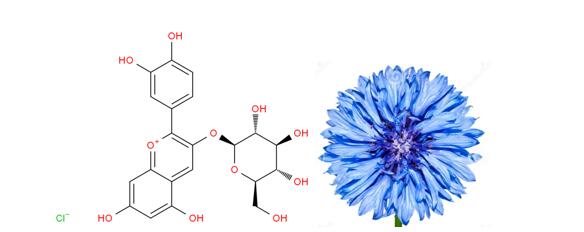
Chrysanthemin is a kind of anthocyanin and it is the 3-glucoside of cyanidin. Chrysanthemin can be found in the roselle plant (Hibiscus sabdariffa, Malvaceae), different Japanese angiosperms and Rhaponticum (Asteraceae), the fruits of the smooth arrowwood (Viburnum dentatum, Caprifoliaceae) appear blue and one of the major pigments is cyanidin 3-glucoside, although the total mixture is very complex. Chrysanthemin is also can be found in blackcurrant pomace, European elderberry, red raspberries, soybean seed coats, victoria plum, peach, lychee and açaí. Chrysanthemin is also can be detected in the red oranges and black rice.
Scientists at Creative Proteomics utilize a highly quantitative method with high-performance liquid chromatography (HPLC) for the determination of Cyanidin-3-O-glucoside (Chrysanthemin) levels in various samples, including Plant, Tissue and more. High-Performance Liquid Chromatography (HPLC) with UV detection is used for the determination of C3G (530 nm) levels in a lot of biological samples. This Methodology provides accurate, reliable, and reproducible results of Cyanidin-3-O-glucoside (Chrysanthemin) measurement, which enables us to analyze of C3G levels in vitro and in vivo.
Chrysanthemin is the major anthocyanin of purple corn (Zea mays), which is approved in Japan and listed in the "Existing Food Additive List" as purple corn color. By the mean of metabolic genetic engineering,the biosynthesis of cyanidin 3-O-glucoside in Escherichia coli was reported in many research papers. A glycosyltransferase, called as UGT79B1 is involved in the anthocyanin biosynthetic pathway in Arabidopsis thaliana, UGT79B1 protein converts cyanidin 3-O-glucoside to cyanidin 3-O-xylosyl (1→2) glucoside.
The Russian-Polish botanist M. Tswett is generally recognized as the first person to establish the principles of chromatography. In a paper he presented in 1906, Tswett described how he filled a glass tube with chalk powder (CaCO3) and, by allowing an ether solution of chlorophyll to flow through the chalk, separated the chlorophyll into layers of different colors. He called this technique “chromatography”. Fundamentally, chromatography is a technique used to separate the components contained in a sample. High Performance Liquid Chromatography (HPLC) is a method able to separate non-volatile, thermally unstable, and polar components separate or in a mixture. HPLC is a type of chromatography that, because of its wide application range and quantitative accuracy, is regarded as an indispensable analytical technique, particularly in the field of organic chemistry. It is also widely used as a preparation technique for the isolation and purification of target components contained in mixtures.
Cyanidin-3-O-glucoside (Chrysanthemin) Analysis Service at Creative Proteomics supports your research in Cyanidin-3-O-glucoside (Chrysanthemin) Analysis. HPLC Based Analysis Service Platform enable us at Creative Proteomics offers you a state-of-the-art Analysis Service.
Sample Type
Plant, Tissue and more
Method
High-Performance Liquid Chromatography (HPLC) with UV detection is used for the determination of C3G (530 nm) levels in a lot of biological samples. This Methodology provides accurate, reliable, and reproducible results of Cyanidin-3-O-glucoside (Chrysanthemin) measurement, which enables us to analyze of C3G levels in vitro and in vivo.
Send us your samples, you will get all information that you need!







